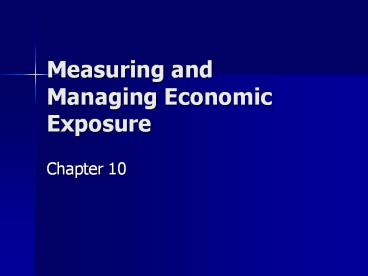Measuring and Managing Economic Exposure Chapter 10 * * * PowerPoint PPT Presentation
1 / 23
Title: Measuring and Managing Economic Exposure Chapter 10 * * *
1
Measuring and Managing Economic Exposure
- Chapter 10
2
Steps to the Creation of an Economic Exposure
Strategy
- Step 1. Identifying the exposure
- Step 2. Define the risk
- Step 3. List the operating exposures
- Step 4. Measuring economic exposure
- Step 5. Guidelines to create strategy
- Step 6. Methods to manage risk
3
IDENTIFYING FOREIGN EXCHANGE RISK AND ECONOMIC
EXPOSURE
- I. FOREIGN EXCHANGE RISK Step I.
- A. Economic exposure defined
- focuses on the future impact of unexpected
currency fluctuations on firms value. - 1 . The most important aspect of foreign
exchange risk management - Incorporate expectations about the risk
into all basic decisions of the firm.
4
Step 2. Define the risk
- 2. Definition
- Economic exposure
- Transaction exposure
- Operating exposure
- arises because currency fluctuations
alter a companys future revenues and
expenses.
5
FOREIGN EXCHANGE RISK AND ECONOMIC EXPOSURE
- B. Real Exchange Rates Changes and Risk
- Nominal v. real exchange rates
- real rate has been adjusted for
- price changes.
- Assume no two nations have the same annual
rate of inflation.
6
FOREIGN EXCHANGE RISK AND ECONOMIC EXPOSURE
- C. Implications
- 1. If nominal rates change with an equal
price change, no alteration to cash flows. - 2. If real rates change, it causes
relative price changes and changes in
purchasing power.
7
FOREIGN EXCHANGE RISK AND ECONOMIC EXPOSURE
- Operating Exposure begins
- the moment a firm starts to invest in a market
subject to foreign competition - or
- in sourcing goods or inputs abroad
8
Step 3 List the new risks
- Operating exposure begins with
- New product development
- A distribution network
- Brand name development
- Marketing to foreign markets
- Foreign supply contracts
- Overseas production facilities
9
Step 4. Measuring economic exposure
- To measure operating exposure requires a
longer-term perspective. - i.e. Cost and price competitiveness
could be affected by unexpected exchange rate
changes
10
FOREIGN EXCHANGE RISK AND ECONOMIC EXPOSURE
- A decline in the real value of a currency
- makes exports and import-competing goods more
competitive - An appreciating currency makes
- imports and export-competing goods more
competitive
11
FOREIGN EXCHANGE RISK AND ECONOMIC EXPOSURE
- During an appreciation of home currencies
- Exporters face two choices
- keep prices constant (but lose sales)
- or
- adjust prices to foreign currency to maintain
market share (lose profits)
12
FOREIGN EXCHANGE RISK AND ECONOMIC EXPOSURE
- 3. SUMMARY
- a. the economic impact of a currency
change depends on the offset by the difference
in inflation rates or the change in real
exchange rates. - b. It is the relative price changes that
ultimately determine a firms long-run
exposure.
13
Step 5. Guidelines to create a strategy
- I. ECONOMIC CONSEQUENCES
- The impact on Operating Exposure of a real
rate change depends upon - Pricing flexibility and
- 1. Price elasticity of demand 2. Degree of
product differentiation - 3. The Ability to shift production and the
substitution of inputs
14
If HC Appreciates
Pricing Flexibility is key
15
If HC Appreciates
- Can the firm maintain its profit margins both at
home and abroad? - If price elasticity of demand is low, the more
price flexibility a firm has. - i.e. Availability of good substitutes
- The Ford Corp in Indonesia, 1997
16
If HC Appreciates
- Product Differentiation
- price elasticity depends on degree of
differentiation - The greater the differentiation, the more the
firm can control its prices. - e.g. Daimler Chrysler Corp.
17
If HC Appreciates
- The Ability to Shift Production and to source
inputs from other countries - e.g. Japanese car makers (Toyota) in the
late 1980s
18
Step 6. Strategies to manage economic exposure
- I. INTRODUCTION
- Operating exposure management requires long-term
operating adjustments and - the involvement of ALL departments.
19
MANAGING OPERATING EXPOSURE
- II. Marketing Strategy
- A. Market Selection
- use competitive advantage to carve out market
share when currency values change
20
MANAGING OPERATING EXPOSURE
- B. Pricing strategy Expectations critical
- 1. If HC depreciates, exporter gains
- competitive advantage by increasing unit
profitability or market share. - 2. The higher price elasticity of demand,
the more currency risk - the firm faces by other product
substitution.
21
MANAGING OPERATING EXPOSURE
- C. Product Strategy
- exchange rate changes may alter
- 1. The timing of new product introductions,
- 2. Product deletion
- 3. Product innovations
22
MANAGING OPERATING EXPOSURE
- III. Product Management Adjustments
- A. Input mix shop the world
- B. Shift production among plants
- C. Plant relocation (new)
- D. Raising productivity
23
MANAGING OPERATING EXPOSURE
- IV. Planning For Exchange-Rate Changes
- A. Develop contingency plans
- with plausible scenarios
- before the impact of a currency change
makes itself felt. - e.g. flexible mfg systems

